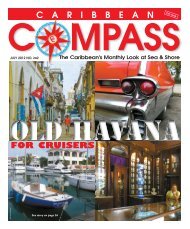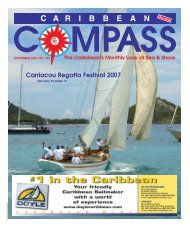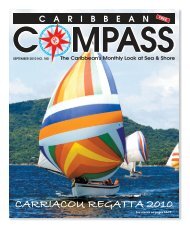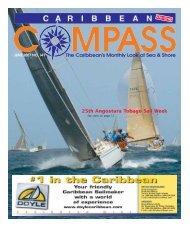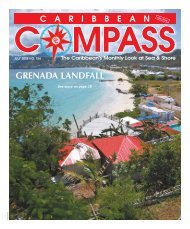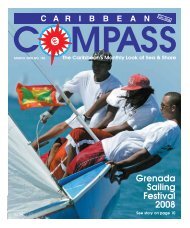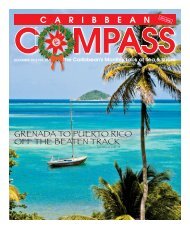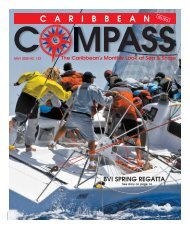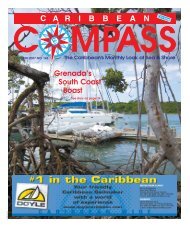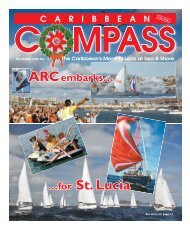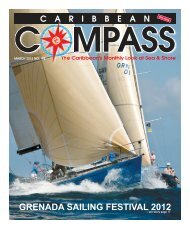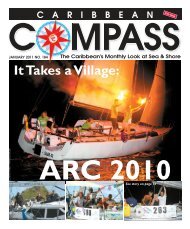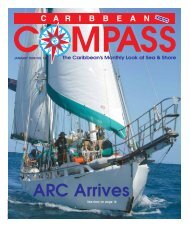You also want an ePaper? Increase the reach of your titles
YUMPU automatically turns print PDFs into web optimized ePapers that Google loves.
DIFFERENT BOATS FOR DIFFERENT FOLKS BY NORMAN FARIA<br />
RED (LUG) SAILS<br />
IN THE SUNSET<br />
It was a beautiful, if unusual, sight: a thick-looking, plumb-stemmed replica of a<br />
19th century lug-sailed British fishing boat beating up into Barbados’ Carlisle Bay<br />
in front of a dying sun.<br />
It was the Veracity with proud owner Marcus Rowden and his companion Jess<br />
Harris on board.<br />
A few days later, I rowed out to them and learned the remarkable story of how this<br />
fine-looking replica was built and also about the fascinating history of that particular<br />
working craft.<br />
It is called a pilchard driver, and hundreds of them sailed out of fishing ports on<br />
England’s southwest coast in their heyday from 1750 through the early 1900s.<br />
Veracity was actually the name of one of them (registration number PZ111), built in<br />
1902 at Mousehole Harbour near Penzance by a staunch Methodist (hence the<br />
name), Paul Humphreys.<br />
Marcus and Jess, cruising the <strong>Caribbean</strong> aboard the replica ‘pilchard<br />
driver’ fishing boat Veracity<br />
Marcus explained that the plans were obtained from the Maritime Museum. He<br />
faithfully followed them, the minor changes including raising the freeboard by one<br />
foot to give more room inside the cabin. It took him one year to build the replica in<br />
the Dartmouth area. He used one-and-a-half-inch-thick larch for planking, copper-<br />
fastened over oak frames. Original boats used mainly pitch pine or red pine on oak<br />
with fastenings being wooden or iron spikes. There were two versions: one, like the<br />
Veracity, was 30 feet LOA, while larger models up to 60 feet were also built according<br />
to the owners’ finances. The smaller one, called a Tosher, could be built on the beach<br />
in three months. The beach also supplied the stones for internal ballast — just like<br />
beaches in the <strong>Caribbean</strong> did for the working schooners here.<br />
The pilchard drivers had to be fast. As with most fishing boats, they had to get to<br />
the market at certain times — the tides also played a part — and catch the vendors.<br />
Hence the 1400-square-foot spread of canvas on the dipping lug sails to get them<br />
out to the fishing banks and back on broad reaches from the prevailing westerly<br />
winds. Marcus said the smaller boats could get up to six knots. Sails were usually<br />
reddish-brown from oak tanning and boiled linseed oil. A 30-footer could carry five<br />
tonnes of pilchard, some of which found their way into Italian markets (probably in<br />
brine-filled casks).<br />
By the 1920s, as Marcus explained, the pilchards were gone. The boats rotted<br />
away. Some were preserved and are raced every summer in a vibrant owners’ association<br />
to which Marcus belongs. Jess’s mother has a 42-foot version, the Lorraine,<br />
which she crewed and virtually grew up on. (See the website www.veracitylugger.<br />
co.uk for photos.)<br />
Like most working craft of that era, the pilchard luggers didn’t have engines.<br />
Veracity (the replica) didn’t when it was first launched in 2004. When visiting<br />
Portugal on the present trip, Marcus installed an electric<br />
motor made by the Lynch Motor Company in<br />
Devon. It develops 30 horsepower and leaves the boat’s<br />
interior spacious and free of diesel fumes. The eight<br />
batteries also add to the three tonnes internal ballast.<br />
Another two tonnes are on the outside in the keel.<br />
Marcus, who is from Brixham where another type of<br />
fishing boat — the famous Brixham trawler — evolved,<br />
said he and Jess left England last year in August. They<br />
visited Senegal and Gambia before calling at the<br />
Canaries and crossing the Atlantic to Barbados.<br />
Like some of the original builders who may have gotten<br />
fittings from wrecked craft, Marcus used a lot of<br />
recycled equipment. The big wood-and-coal-burning<br />
AGA stove in the cabin came from a Scottish farm. The<br />
Aries self-steering gear was acquired, like some other<br />
fittings, from a second-hand store. Marcus, who worked<br />
in boatyards, also fabricated some of the metal fittings<br />
from scrap metal.<br />
It was indeed a pleasure to speak with Marcus and<br />
Jess about this project in keeping alive a part of the<br />
rich cultural traditions the British fishing culture. They<br />
asked to be kept informed of a similar project in<br />
Barbados to build a replica of a traditional Bajan<br />
(gunter-rigged with internal ballast) sailing flying fish<br />
boat of the 1940s and ’50s which itself was influenced<br />
by British vernacular design.<br />
NORMAN FARIA (2)<br />
The Beauty of Steel<br />
From the shore, the wooden mast gave it away.<br />
The dark-hulled sloop out in Barbados’s Carlisle Bay anchorage must be 1950s<br />
vintage, I thought. Which boat built these days would have such a spar?<br />
And the curving sheer and spoon bow also spoke of another era.<br />
Yes, the Zeevonk, as it is named, was made in 1954 in the Netherlands by the<br />
Huisman firm. This was the smaller firm — not the one making luxury boats,<br />
explained its owner Wouter De Boer. And Zeevonk was made of steel.<br />
“Is it a class boat? How many were made? And how do you keep it so well maintained?”<br />
I asked Wouter.<br />
“It was a one-off. The first owner worked for the Dutch airline KLM and he apparently<br />
had access to materials like steel plate. He seemed to love it because he sailed<br />
it around the Baltic Sea until 1983 when he passed it on to his daughter and I<br />
bought it from her in 1991,” he answered.<br />
He continued: “The builders did a good job but with all metal boats there is a certain<br />
amount of chipping and painting to be done. There was a big refit in the 1970s.”<br />
Wouter said he had rearranged the cabin layout. Most of the interior wood was<br />
still good, but he also used some recycled oak from a bed frame he found in a<br />
garbage skip.<br />
The original mast and boom are made of white spruce from the US. The original<br />
galvanised turnbuckles and other fittings however were replaced with stainless steel<br />
gear. The first engine was a British-made Coventry Victor but there is now an<br />
18-horsepower Yanmar, put in four years ago.<br />
And the name hasn’t been changed either. It means “sea spark” or “phosphorescence”.<br />
The Netherlands has a deep tradition of boat and ship building in steel. “We were<br />
smart in Holland. We were making steel barges around 1900. It made sense in many<br />
ways, such as having more space inside, and lasting longer than wood,” said<br />
Wouter.<br />
Wouter, 37, says he too loves the boat. “There’s the beauty of the compound curves<br />
in this type of boat and it really sails well, too,” he says. He made the crossing from<br />
the Canaries in 22 days, a fairly good passage.<br />
Sometimes he has to haul Zeevonk out in yards and head back to his hometown of<br />
Amsterdam to work. Wouter plans to see some of the <strong>Caribbean</strong> before moving on.<br />
A spoon bow and sweet sheer distinguish Wouter De Boer’s 55-year-old,<br />
steel-hulled beauty<br />
MAY <strong>2009</strong> CARIBBEAN COMPASS PAGE 29




